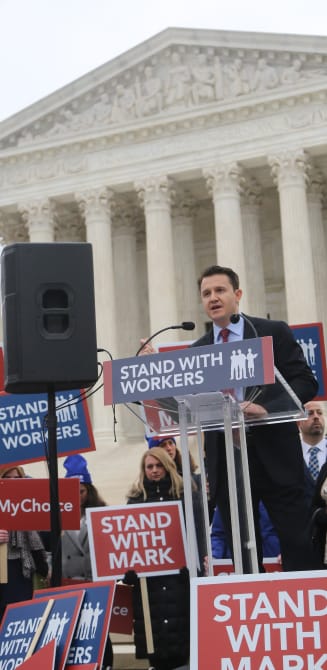The Arizona Department of Education (ADE) just reported that almost 6,500 new families have applied for the Empowerment Scholarship Account (ESA) program for their students under the new universal school choice legislation that state lawmakers passed this year. On cue, union activists are up in arms. Why? Because apparently they’re not the right kinds of students.
According to ADE, the majority of the students “do not have a prior record of AZ public school enrollment,” meaning that they aren’t students switching from a public school. Activists are now rolling out their usual claims that ESAs actually don’t help families trapped in mediocre public education, but simply help students already in private or homeschool settings who don’t need it. So let’s be clear about a few points:
- First, the surge in ESA interest in these first few weeks is something to celebrate. Trying to label some students as deserving and others as undeserving is reprehensible.
- The ESA program treats all students, regardless of where they’re coming from or their family’s background, as equal.
So, let’s consider these new applications in particular, and specifically the timing:
- The first day of school for most kids in Arizona was in early August. Yet ADE waited almost two months after this legislation was passed to put the application online, meaning families couldn’t even apply until after they had already situated their kids in a school for this year. As a result, any public school family interested in an ESA this year would have to pull their child out mid-year. It’s not exactly a surprise that families—even those who are dissatisfied with their children’s school—try not to turn their kids’ worlds upside down in the middle of a semester. Instead, they wait for a smooth break over a semester or school year. That’s why most ESA applications from students switching from public schools have always come in the spring and early summer—that is, before school starts—so that parents can actually get their kids enrolled in a new school or situated for at-home education in time for the semester. Due to this year’s timeline, parents had to make their plans for fall 2022 long before they would have any additional options via an ESA.
- Thanks to the threat from union activists, this obstacle is even more acute for public school students this year. Families can’t even be sure that they’ll have an answer about whether or not they’ll actually get their ESA funding for their kids by late September—nearly two months into the school year—at the earliest.
- This means families who desperately want to get their kids out of public schools and into a different environment, but can’t afford it, are being asked to bank their hopes on a program that activists are actively collecting signatures to try shutting down—in the middle of the school year, no less.
- Unfortunately, these same sort of union activists have already shown a willingness to pull the rug out from underneath parents without the slightest sympathy. Last year, West Virginia passed a similar ESA program that was slated to begin funding kids’ private or at-home education options this fall. Yet just last month, union leaders successfully sued to put the program on hold, just weeks before school was slated to start and after some 4,500 families had already applied and/or been approved for scholarships. So now those families—virtually all of whom were switching from a public school and making plans for private or at-home education—have been thrown into limbo and left to scramble for themselves.
So yes, it’s rather understandable that public school families in Arizona are taking a wait-and-see approach.
And what about those applications from families already outside the public school system?
- The unions may want us to forget, but let’s remember that their draconian COVID mandates drove out 50,000 students from Arizona public school districts in 2020, and as of this past year, nearly 17,000 former district students had still not returned to the public school system. So all these kids—who were actively failed by the district school system—are no longer public school students. That means that funding them with an ESA would technically be funding a kid who’s already outside the public school system—so by the unions’ logic, it would be funding a child who doesn’t need help. But to suggest that these kids aren’t just as deserving of help as they were before public schools failed them during the pandemic is insulting.
- More broadly, thousands of Arizona families currently make the financial sacrifice to stay home to educate their children themselves or pay for private school tuition. These families, who each pay thousands of dollars a year in property and sales taxes to support other kids’ education, currently save Arizona taxpayers hundreds of millions of dollars every year by shouldering the burden and costs of educating their own kids themselves, rather than adding them to the rolls of public schools. Are they and their kids really less deserving than their neighbors?
- The doublespeak from union activists on this issue is appalling. Our public school system doesn’t say, “Well certain kids deserve to have taxpayers support their education, but not others.” No, every kid who walks in the door of a public school gets roughly $11,000 from state taxpayers spent on their public education each year, no matter how poor or wealthy their family is. We don’t have income caps on whose K-12 education taxpayers deem worthy of support. Taxpayers are required to support the education of every student in the state who shows up to a public school, and unless I missed it, Save Our Schools and the like haven’t called for limiting all public school funding to only certain kids who “need it.”
- Rather, just as every family in Arizona has a right to send their child to a public school (at taxpayer expense), the ESA program ensures every family in Arizona has an equal opportunity to participate in private or at-home education via a portion of the taxes they already pay each year. Especially considering that the median tuition rate for Arizona private schools is approximately $6,500 for grades K-8—which is on par with the typical ESA award—it’s clear that ESAs bring these options to within reach of all families. Again, this is something to celebrate.
Finally, let’s not forget that Arizona lawmakers added over $600 million of new ongoing funding for public schools at same time they authorized the ESA expansion this year. Arizona lawmakers have shown a willingness to fund all students—public, private, or home-educated. Union shock troops, on the other hand, want to fund only the students whose education they directly control. And that indeed, is a position unworthy of parents’ and voters’ respect.
Matt Beienburg is the Director of Education Policy at the Goldwater Institute. He also serves as Director of the institute’s Van Sittert Center for Constitutional Advocacy.









